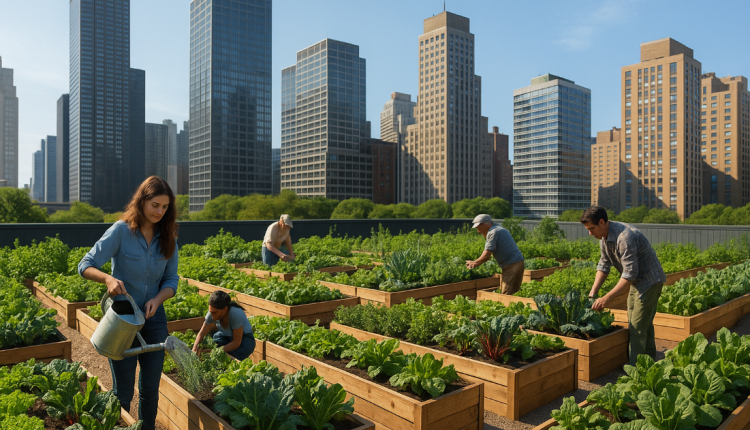- Advertisement -
As the global population continues to urbanize, cities are becoming denser and more detached from traditional forms of food production. Towering skyscrapers and sprawling concrete expanses have pushed agriculture to the fringes of urban life, creating a disconnection between people and the origins of their food. However, an emerging movement is beginning to rewrite this narrative—urban farming. By integrating agriculture into the very fabric of city life, urban farms are not only revitalizing local ecosystems but also reshaping the way we think about food, sustainability, and our relationship with nature.
Urban agriculture is no longer a fringe concept. From rooftop gardens to vertical farms and community plots, the return of food cultivation to city centers is revolutionizing urban environments. This article explores the environmental benefits of urban farming, how it reduces the carbon footprint of food transportation, and why this growing trend is crucial for building sustainable cities of the future.
Greening the Grey: Urban Farms and Environmental Regeneration
One of the most visible and immediate impacts of urban farming is the greening of urban spaces. Cityscapes, often dominated by concrete and asphalt, are being transformed by patches of green life. Rooftop gardens, hydroponic systems, and converted vacant lots bring color and biodiversity back to urban neighborhoods.
These green spaces contribute to the urban ecosystem in several key ways. First, they help combat the urban heat island effect—a phenomenon where cities become significantly warmer than surrounding rural areas due to heat absorption by buildings and pavement. Vegetation cools the air through shade and evapotranspiration, mitigating temperature extremes and reducing the need for energy-intensive air conditioning.
Second, urban farms support biodiversity by providing habitat for pollinators such as bees and butterflies, as well as other beneficial insects and birds. In cities where natural habitats have been erased, these green oases serve as critical refuges for wildlife. Additionally, the use of organic farming practices in urban agriculture avoids the harmful effects of chemical pesticides and fertilizers, promoting soil health and ecological balance.
Reducing the Food Transport Footprint
A major environmental benefit of urban agriculture lies in its potential to drastically reduce the transportation required to bring food to urban consumers. In the conventional food system, produce often travels hundreds or even thousands of kilometers before reaching the plate. This long supply chain contributes significantly to greenhouse gas emissions through the burning of fossil fuels in transportation.
Urban farming shortens the supply chain by producing food within or near the city where it will be consumed. This not only reduces emissions but also minimizes the need for refrigeration and packaging during transport. Moreover, locally grown produce can be harvested at peak ripeness, ensuring higher nutritional quality and reducing food waste caused by spoilage in transit.
By localizing food production, urban agriculture fosters a more resilient food system—one less vulnerable to global supply chain disruptions and the environmental toll of long-distance shipping. It also encourages seasonal eating and greater awareness of where food comes from, promoting more sustainable consumption habits among urban dwellers.
Air Quality Improvement and Carbon Sequestration
In addition to cooling urban environments, urban farms improve air quality by filtering pollutants and capturing carbon dioxide. Plants absorb CO₂ during photosynthesis, contributing to the reduction of atmospheric carbon levels. While the scale of carbon sequestration in urban farms may not rival large-scale reforestation, their cumulative effect across multiple installations can still provide meaningful benefits.
Vegetation also traps airborne particulates, such as dust and vehicle emissions, improving respiratory health for city residents. In densely populated areas where air pollution poses a significant health risk, even modest improvements in air quality can lead to measurable public health benefits.
Water Management and Waste Reduction
Urban agriculture often incorporates innovative water management systems, including rainwater harvesting, greywater recycling, and efficient irrigation methods like drip systems. These practices reduce reliance on municipal water supplies and help prevent stormwater runoff, a major cause of urban water pollution.
Moreover, many urban farms integrate composting systems that turn organic waste into nutrient-rich soil. This not only diverts food scraps from landfills—where they would produce methane, a potent greenhouse gas—but also closes the nutrient loop in a sustainable way. Urban composting reduces the need for synthetic fertilizers, supports soil regeneration, and reinforces the principles of a circular economy.
Social Cohesion and Environmental Awareness
Beyond the tangible environmental impacts, urban farming nurtures a deeper cultural shift toward environmental consciousness. Community gardens and cooperative farms bring residents together, fostering social ties and collective responsibility for shared green spaces. In neighborhoods that may lack access to fresh produce or green areas, these farms serve as vital resources for nutrition, education, and recreation.
Educational programs centered around urban agriculture teach children and adults alike about the life cycle of food, the importance of ecological stewardship, and the practical skills of cultivation. These experiences cultivate a more environmentally literate population—one that values sustainability and is empowered to take action in their own communities.
The Future of Sustainable Cities
Urban farms represent a powerful tool in the broader effort to make cities more sustainable and self-sufficient. As climate change, population growth, and resource scarcity challenge traditional urban planning models, integrating agriculture into the urban landscape becomes not just beneficial but necessary.
Cities around the world are beginning to recognize this potential. Policies that support green roofs, incentivize local food production, and allocate land for urban agriculture are gaining traction. In some regions, urban farms are being integrated into affordable housing developments, hospitals, and schools—embedding sustainability into the daily lives of city dwellers.
Technological innovations are also driving the growth of urban farming. Vertical farming, hydroponics, and aeroponics allow for high-yield food production in small spaces with minimal environmental impact. These methods can operate indoors, under controlled conditions, and require significantly less water and land than traditional agriculture.
Conclusion
Urban agriculture is more than a trend—it is a transformative movement that redefines the relationship between cities and nature. By bringing food production back into the heart of urban life, city farms provide a host of environmental benefits, from reducing carbon footprints to improving air quality and enhancing biodiversity. They foster resilient food systems, reconnect people with the natural world, and promote a culture of sustainability.
As megacities grapple with the ecological and social challenges of the modern age, urban farming offers a path forward—one that is green, inclusive, and deeply rooted in the principles of harmony with nature. The return to nature is not a retreat from progress, but a reimagining of it, grounded in ecological wisdom and a vision of cities that nourish both people and the planet.

